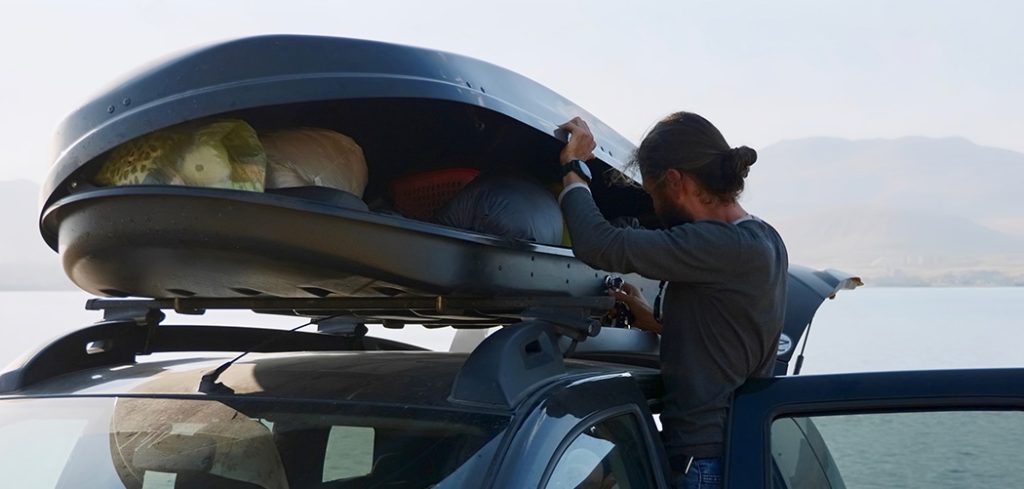
Welcome to Our Car Roof Boxes and Carriers Glossary
Unlock the world of car roof boxes with our comprehensive glossary. Whether you’re a road-trip enthusiast or new to rooftop cargo solutions, our guide provides clear definitions for key terms. From roof box types to security features, we’ve crafted an easy-to-understand resource for both beginners and experts.
Explore mounting systems, delve into aerodynamics, and grasp safety guidelines. Each entry is enriched with SEO keywords to enhance your digital understanding. Whether you’re eyeing specific brands, materials, or accessories, our glossary demystifies the language of car roof boxes.
Empower yourself with knowledge for confident decision-making on your next journey. Welcome to a concise and insightful exploration of car roof boxes and carriers.

Glossary of Roof Box Definitions
Roof Box and Roof Box Types
Cargo Boxes: Cargo boxes are enclosed, rigid containers mounted on a vehicle’s roof, providing secure and weather-resistant storage space for various items such as luggage, sports gear, and camping equipment.
- Roof Baskets: Roof baskets are open-weave or mesh-like structures mounted on a vehicle’s roof, offering a versatile platform for securing bulky or oddly shaped items, such as sports gear, camping equipment, or outdoor gear.
- Rooftop Bags: Rooftop bags are flexible, weather-resistant containers that can be secured to a vehicle’s roof, providing additional storage space for soft items like clothing, bedding, or camping gear. They are often a more compact and economical option.
- Hitch-Mounted Cargo Carriers: Hitch-mounted cargo carriers are storage platforms attached to a vehicle’s hitch receiver, typically at the rear. These carriers are suitable for transporting larger items, such as bicycles, coolers, or additional cargo, without the need for a roof rack.
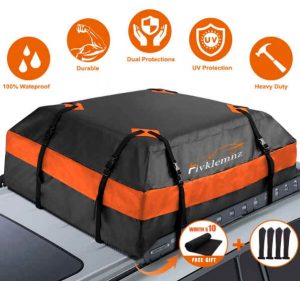 Materials:
Materials:
ABS (Acrylonitrile Butadiene Styrene): ABS is a thermoplastic polymer known for its strength, durability, and impact resistance. In the context of car roof boxes, ABS is a commonly used material due to its ability to withstand harsh weather conditions and provide robust protection for stored items.
Aluminum Alloy: Aluminum alloy is a lightweight yet sturdy material composed of aluminum mixed with other metals. In the realm of car roof boxes, aluminum alloy construction is valued for its corrosion resistance, strength-to-weight ratio, and sleek appearance.
Fiberglass: Fiberglass is a composite material made of fine glass fibers embedded in resin. When used in car roof boxes, fiberglass offers a balance of strength and weight reduction. It is appreciated for its durability and resistance to environmental elements.
Polyethylene: Polyethylene is a thermoplastic polymer with a wide range of applications. In the context of car roof boxes, polyethylene is chosen for its lightweight nature, resistance to impacts, and ability to endure exposure to the sun and other weather conditions.
Mounting Systems:
 Crossbars: Crossbars are horizontal bars mounted on a vehicle’s roof, forming the foundation for attaching various roof-mounted accessories, including roof boxes. They serve as a secure base for the installation of cargo carriers and are often part of a roof rack system.
Crossbars: Crossbars are horizontal bars mounted on a vehicle’s roof, forming the foundation for attaching various roof-mounted accessories, including roof boxes. They serve as a secure base for the installation of cargo carriers and are often part of a roof rack system.
Roof Rails: Roof rails are longitudinal bars running along the sides of a vehicle’s roof. They provide a framework for the attachment of crossbars and roof-mounted accessories, offering a streamlined and integrated solution for carrying cargo.
Roof Rack Systems: Roof rack systems are comprehensive setups consisting of crossbars, roof rails, and various attachments. These systems are designed to facilitate the secure mounting of cargo carriers, including roof boxes, providing a versatile solution for transporting gear and equipment.
U-bolt Mounting: U-bolt mounting is a method of securing roof boxes to crossbars using U-shaped bolts. These bolts wrap around the crossbars and are tightened to create a firm and stable connection, ensuring the roof box remains securely attached during travel.
Capacity and Size:
Cubic Feet (cu ft): Cubic feet (cu ft) is a measurement unit used to quantify the storage volume or capacity of a car roof box. It represents the amount of space available inside the box for storing cargo, helping users understand the box’s size and suitability for their needs.
Length, Width, Height Dimensions: Length, width, and height dimensions refer to the physical measurements of a car roof box. These dimensions help users assess the box’s size and compatibility with their vehicle and cargo. Length is the longest dimension, width is the side-to-side measurement, and height is the vertical measurement.
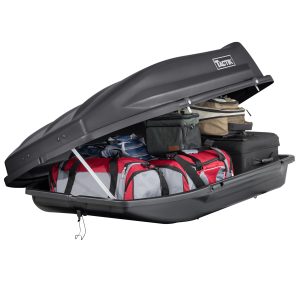 Load Capacity: Load capacity is the maximum weight that a roof box can safely carry. It includes the weight of the box itself and the items stored inside. Understanding the load capacity is crucial to prevent overloading and ensure safe transportation of belongings.
Load Capacity: Load capacity is the maximum weight that a roof box can safely carry. It includes the weight of the box itself and the items stored inside. Understanding the load capacity is crucial to prevent overloading and ensure safe transportation of belongings.
Max Load Weight: Max load weight is the total weight of the cargo and the roof box combined. It is a critical consideration for safe driving and vehicle performance. Exceeding the specified max load weight can compromise the box’s structural integrity and affect the vehicle’s handling.
Security Features:
Dual-Side Opening: Dual-side opening refers to a security feature in roof boxes where the lid can be opened from both sides of the box. This design enhances accessibility and convenience, allowing users to load and unload items from either side of the vehicle.
Locking Mechanisms: Locking mechanisms in roof boxes are systems designed to secure the box and its contents. These can include traditional key locks, combination locks, or more advanced locking systems. The primary purpose is to deter theft and ensure that the roof box remains securely closed during transit.
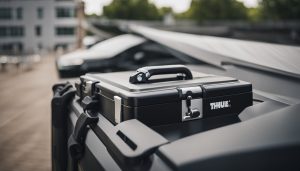 One-Key System: A one-key system is a security feature that allows a single key to operate multiple locks on a vehicle, including the roof box lock. This convenience simplifies the user experience and reduces the number of keys needed for various car components.
One-Key System: A one-key system is a security feature that allows a single key to operate multiple locks on a vehicle, including the roof box lock. This convenience simplifies the user experience and reduces the number of keys needed for various car components.
Secure Latch Systems: Secure latch systems are mechanisms that ensure the proper closure and sealing of a roof box. These latches play a crucial role in preventing water ingress, protecting contents from the elements, and maintaining overall security during transportation.
Aerodynamics:
 Drag Coefficient: The drag coefficient is a dimensionless number that represents the aerodynamic efficiency of an object, such as a car roof box. It quantifies how well the object moves through the air, with lower values indicating reduced air resistance. In roof boxes, a lower drag coefficient contributes to improved fuel efficiency and reduced wind resistance during travel.
Drag Coefficient: The drag coefficient is a dimensionless number that represents the aerodynamic efficiency of an object, such as a car roof box. It quantifies how well the object moves through the air, with lower values indicating reduced air resistance. In roof boxes, a lower drag coefficient contributes to improved fuel efficiency and reduced wind resistance during travel.
Fairing: A fairing is an aerodynamic device attached to the front of a roof box. It is designed to streamline the flow of air over the box, reducing turbulence and minimizing wind resistance. Fairings contribute to improved fuel efficiency and help decrease wind noise during travel.
Wind Noise Reduction: Wind noise reduction refers to features incorporated into roof boxes to minimize the sound produced by the airflow during travel. These features may include aerodynamic shapes, fairings, and specialized designs that contribute to a quieter driving experience.
Wind Tunnel Testing: Wind tunnel testing is a method used to evaluate the aerodynamic performance of a roof box in a controlled environment. During testing, the box is subjected to various wind conditions, allowing manufacturers to optimize its design for reduced drag, improved fuel efficiency, and minimized wind noise.
Installation and Removal:
 Quick Mount Technology: Quick Mount Technology refers to a feature in roof boxes that facilitates fast and efficient installation onto a vehicle’s roof. This technology often involves pre-installed mounting systems, making the process swift and user-friendly, enhancing convenience for users.
Quick Mount Technology: Quick Mount Technology refers to a feature in roof boxes that facilitates fast and efficient installation onto a vehicle’s roof. This technology often involves pre-installed mounting systems, making the process swift and user-friendly, enhancing convenience for users.
Tool-Free Installation: Tool-Free Installation is a method that allows users to attach a roof box to their vehicle without the need for additional tools. Roof boxes with tool-free installation features typically incorporate user-friendly mechanisms, such as hand-tightening knobs or integrated fasteners.
T-Slot Compatibility: T-Slot Compatibility refers to the design of a roof box that allows it to be securely mounted onto roof rack systems with T-shaped slots. This compatibility provides a versatile and stable attachment method, ensuring the roof box is properly secured during travel.
Universal Fitment: Universal Fitment denotes the capability of a roof box to fit a wide range of vehicle makes and models. Roof boxes with universal fitment are designed to accommodate various roof rack systems, ensuring compatibility with diverse vehicles in the market.
Accessories:
 Cargo Nets: Cargo nets are flexible netting systems designed to secure and contain loose items inside a roof box. These nets prevent items from shifting during transit, providing an additional layer of organization and ensuring the safety of stored cargo.
Cargo Nets: Cargo nets are flexible netting systems designed to secure and contain loose items inside a roof box. These nets prevent items from shifting during transit, providing an additional layer of organization and ensuring the safety of stored cargo.
Roof Pads: Roof pads are protective cushions or padding designed to be placed between the roof box and the vehicle’s roof. These pads serve to prevent scratches, abrasions, and damage to the vehicle’s surface during the installation and removal of the roof box.
Roof Rack Adapters: Roof rack adapters are accessories that enable the compatibility of a roof box with specific roof rack systems. These adapters bridge the gap between the roof box mounting mechanism and the roof rack, ensuring a secure and proper fit.
Ski and Snowboard Attachments: Ski and snowboard attachments are accessories designed to transport winter sports equipment on the roof box. These attachments secure skis and snowboards in place, preventing damage to the equipment and maximizing the roof box’s utility during winter activities.
Brands and Manufacturers:
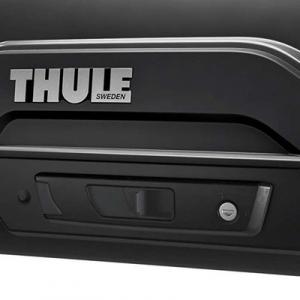 Thule: Thule is a renowned brand and manufacturer specializing in outdoor and transportation products, including car roof boxes. Thule roof boxes are known for their high-quality construction, innovative design, and a wide range of models catering to various user needs.
Thule: Thule is a renowned brand and manufacturer specializing in outdoor and transportation products, including car roof boxes. Thule roof boxes are known for their high-quality construction, innovative design, and a wide range of models catering to various user needs.
Yakima: Yakima is a leading brand that produces a diverse range of outdoor gear, with a focus on roof racks and cargo solutions. Yakima roof boxes are recognized for their durability, versatility, and user-friendly features, making them a popular choice among outdoor enthusiasts.
RoofPax: RoofPax is a brand specializing in roof boxes and rooftop cargo carriers. RoofPax roof boxes are known for their robust construction, spacious interiors, and weather-resistant features, providing reliable solutions for those seeking additional storage space for their travels.
SportRack: SportRack is a brand that offers a variety of affordable and practical solutions for outdoor enthusiasts, including roof boxes. SportRack roof boxes are recognized for their user-friendly designs, ease of installation, and providing a cost-effective option for those seeking additional cargo space.
Safety Guidelines:
Center of Gravity: The center of gravity refers to the point on a roof box where the weight is evenly distributed in all directions. Maintaining a low and centered center of gravity is crucial for vehicle stability and handling, especially during turns and sudden maneuvers.
Overhang Considerations: Overhang considerations involve assessing the protrusion of the roof box beyond the front or rear of the vehicle. Ensuring that the roof box is properly aligned and does not excessively overhang is important to prevent interference with the vehicle’s aerodynamics and visibility.
 Weight Distribution: Weight distribution involves the even spread of cargo inside the roof box to prevent imbalances. Proper weight distribution contributes to stable driving conditions and minimizes the risk of overloading, ensuring that the weight is distributed evenly across the vehicle.
Weight Distribution: Weight distribution involves the even spread of cargo inside the roof box to prevent imbalances. Proper weight distribution contributes to stable driving conditions and minimizes the risk of overloading, ensuring that the weight is distributed evenly across the vehicle.
Weight Limitations: Weight limitations indicate the maximum load a roof box can safely carry. Adhering to these limits is crucial to prevent damage to the roof box, maintain vehicle stability, and ensure overall safety during transportation.

Glossary of Roof Box Terms
A
- Aerodynamic Drag: The resistance a roof box encounters when moving through the air.
- Alpine: A style of roof box with a longer and narrower design, suitable for skis and snowboards.
C
- Capacity: The volume or storage space inside the roof box, often measured in cubic feet (cu ft).
- Cargo Management System: Features designed to organize and secure items within the roof box.
- Crossbars: Horizontal bars mounted on a vehicle’s roof to support roof boxes.
D
- Drag Coefficient: A measure of the aerodynamic efficiency of the roof box, influencing its resistance to air.
- Dual-Side Opening: A feature allowing the roof box lid to be opened from both sides for convenient access.
F
- Fairing: A wind deflector attached to the front of the roof box to reduce wind noise.
- Fit Kit: Customized hardware for specific vehicles to ensure a secure fit.
H
- Hitch-Mounted Cargo Carrier: A cargo carrier attached to the vehicle’s hitch receiver, suitable for larger items like bikes or coolers.
I
- Installation: The process of attaching the roof box to a vehicle, often involving mounting systems like crossbars or roof rails.
L
- Load Capacity: The maximum weight a roof box can safely carry, including both the box and its contents.
- Locking Mechanism: The system used to secure and lock the roof box, ensuring the safety of stored items.
M
- Materials: The substances used in constructing the roof box, such as ABS, aluminum alloy, fiberglass, or polyethylene.
O
- Overhang: The extension of the roof box beyond the front or rear of the vehicle, affecting aerodynamics and visibility.
- One-Key System: A system allowing a single key to operate multiple locks on the roof box for user convenience.
P
- Polyethylene: A lightweight and durable material commonly used in roof box construction.
Q
- Quick Mount Technology: Features that enable fast and efficient installation of the roof box onto the vehicle.
- Quick Release System: A mechanism enabling swift removal of the roof box from the vehicle.
R
- Roof Rack System: The complete set of bars and attachments on a vehicle’s roof for mounting accessories.
- Rooftop Cargo Carrier: A general term for any storage solution mounted on a vehicle’s roof.
S
- Safety Guidelines: Recommendations for safe use, including considerations for weight distribution, center of gravity, and weight limitations.
- Security Features: Elements like dual-side opening, secure latch systems, and one-key systems that enhance the safety of the roof box.
T
- Tool-Free Installation: The ability to mount the roof box without the need for additional tools.
- T-Slot Compatibility: Design that allows the roof box to be securely mounted into T-shaped slots on roof rack systems.
U
- U-bolt Mounting: A mounting system using U-shaped bolts to attach the roof box to crossbars.
W
- Weight Distribution: Ensuring even distribution of weight inside the roof box for stability and safe driving.
- Wind Noise Reduction: Features aimed at minimizing the noise caused by airflow during travel.
- Wind Tunnel Testing: Evaluation of the roof box’s aerodynamics in a controlled wind environment.
- Weather-Resistant Seals: Seals and gaskets that protect the roof box from water and weather elements.